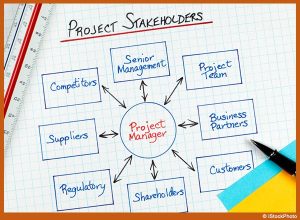3 Managing resources

Human resources are a complex resource to manage. As an introductory summary, it is important to recognise that success in managing others is influenced by:
- the culture and ethos of the project team;
- the quality and timeliness of recruitment (and effectiveness of the process);
- communication and;
- cohesiveness of all stakeholders that are directly involved.
Leadership
A simple way to differentiate between leadership and management is to think of leadership as appealing to commonly held motives of various stakeholders and utilising common wants to inspire many in doing what is needed, whilst management is about motivating individuals to work as a team. Management focuses on the contribution of the individual. The difference is subtle and project managers need to be able to manage and lead others to be successful. Watch this clip by Simon Sinek for a tangible application of leadership as he describes how people at the top can enable the strength of others by satisfying a need we all have to feel safe and certain that what we are doing is acceptable and valued:
Management
Managing others is not limited to controlling subordinates with legitimate power (provided as part of the organisational structure). Project manager must also be able to manage stakeholders with different types of power and influence. Julia Dhar presents one technique that is a little bit different to what you might find in conventional management text, however her main point is poignant; people have opinions and a primary challenge faced by managers is encouraging people to express and listen to divergent views and at the same time cooperate and collaborate.
Combining Leadership and Management
Project Managers use at least three devices to manage effectively; Frameworks or organisational structures; tools and techniques, and finally; effective communication strategies:
- The frameworks that guide paradigms of thinking. Changing the structure of these frameworks affects the way people address work and perceive projects. Good leadership helps achieve positive influence, watch the Simon Sinek clip to see a more tangible example of this point.
- Tools and techniques can be used to encourage, inform and persuade others. These can be overt attributes such as “outlook reminders”/ emails (communication) that politely but firmly reinforce deadlines, which encourages stakeholders to get work tasks done. Techniques could also be subtle, such as giving stakeholders permission to argue in meetings for set periods of time periods, which encourages creative and/or divergent thinking. Watch the Julia Dhar clip to gain a more tangible understanding of this point.
- Implementing and maintaining (constantly improving) a communication strategy. Many projects effectively plan communications but fail to implement them well or disregard components of the Communications Plan when implementation does not go as smoothly as hoped. Effective communication is critical to a project’s success. Most forms, templates and processes used to manage projects are vehicles that can make communication more effective.
Interrelationship of frameworks, tools and communication
The above-mentioned points do not arise in isolation, they are interrelated and overlap. Using Julia Dhar’s talk to make an example:
- Separating ideas from the identity from the person discussing them is a new framework for thinking about new ideas
- Allocating time in routine meetings for debating the way things are done is one technique that will help or start implementing the new framework
- Documenting that that these debates are to be included in meetings by writing them into meeting agendas and recording outcomes in minutes of meeting is the process of including debates in a communication strategy.
Context
It is important to note that this summary is not comprehensive. Management practices is an expansive topic. Management on its own can fill entire qualifications and learning to become a capable manager can take years to develop useful experience. This unit merely introduces the concept of managing others and cannot provide much depth. It is hoped that your desire to learn about effectively managing others is ignited or encouraged.
The text book provides 5-6 pages on motivation theories that are interesting, even enlightening, however these theories do not provide practical instructions about how to execute projects.

